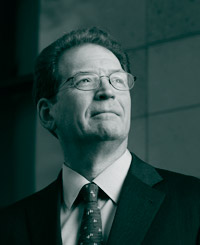SUMMER 2013 CONTENTS
Home
Hiding in plain sight
The environmental factor
Priming the pumps
Debugging Dhaka’s water
Close encounters
How we're crossing paths with disease-bearing pests
Street smarts
Using citizen-scientists to fight for healthier neighborhoods
Beyond hurricane heroics
What Sandy should teach us all about preparedness

DOWNLOAD PRINTABLE
ISSUE (PDF)


Glenn Matsumura

In the midst of the fast-paced genetic revolution in health care, generating both basic science discoveries and treatment advances, it’s easy to think that DNA is, in fact, destiny.
But it’s increasingly obvious that the environment — the world outside our bodies — has a significant impact on health in ways that we’re only now discovering. It’s no surprise that air thick with pollutants can be deadly for a person with asthma. But now we know that bad air can cause harm in utero — breathing traffic pollution during early pregnancy is linked to serious birth defects, as pediatrics professor Gary Shaw showed in a recent study.
One way the outside environment can influence our health is by leading to mutations in our DNA sequences, as is the case with cigarette smoke. But another way is by turning certain genes on or off without affecting DNA sequences — a phenomenon called epigenetics. Our external environment sometimes sets epigenetic changes in motion. These effects can be far-reaching. In fact, recent research by associate professor of genetics Anne Brunet demonstrated for the first time that even longevity can be handed down through epigenetic inheritance.
Fortunately, there’s a growing recognition in medicine of the importance of looking at the totality of an individual — in his or her environment — as an indicator of health and as a guide to treatment. It’s not always just test results or the symptoms presented in the clinic that matter, but an individual’s physical environment, socioeconomic status and access to social support.
In fact, many studies have found that health-care spending directed at disease intervention addresses only about one-quarter of the determinants of health. In a study with Stanford economist Victor Fuchs, professor Mark Cullen found that education and family structure are better indicators of life expectancy than access to health care.
For an academic medical center, this is sobering news. It means that preventing and treating disease will take more than groundbreaking research and the best treatments; it will require tackling the underlying environmental factors — be they social, physical or behavioral — that make us sick. It means that health requires a lot more than outstanding doctors and hospitals.
I’d like to thank the Stanford Woods Institute for the Environment for partnering with us on this issue of the magazine and for helping to remind us that health is about more than DNA and medical care. It’s also about the environment.
Sincerely,
Lloyd Minor, MD
Carl and Elizabeth Naumann Dean of the School of Medicine
Professor of Otolaryngology - Head & Neck Surgery

